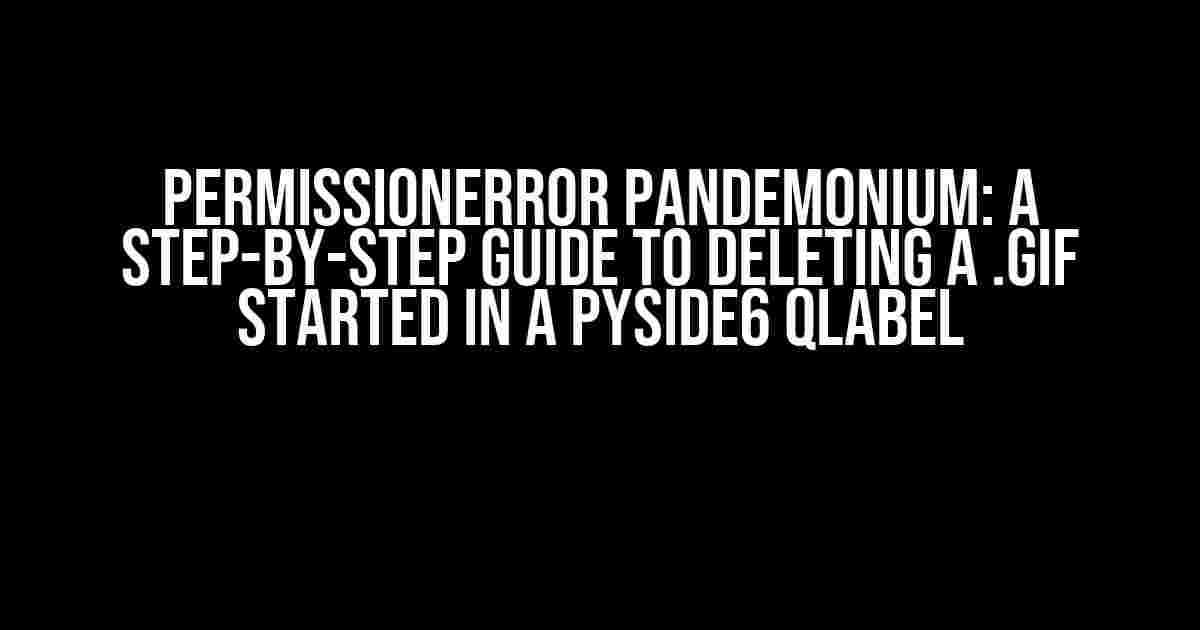Are you tired of encountering the dreaded PermissionError when trying to delete a .GIF file that was previously displayed in a PySide6 QLabel? You’re not alone! This frustrating issue has plagued many a Python developer, but fear not, dear reader, for we’re about to embark on a journey to tackle this problem head-on.
The Culprit: QLabel’s File Locker
Before we dive into the solution, let’s understand the root cause of the issue. When you display a .GIF file in a PySide6 QLabel, the label creates a file handle to the image, which locks the file, preventing other processes (including your own script) from modifying or deleting it. This is a common behavior in many GUI libraries, including Qt, which PySide6 is built upon.
Why Do I Get a PermissionError?
When you attempt to delete the .GIF file while it’s still being displayed in the QLabel, the operating system throws a PermissionError, indicating that the file is currently in use by another process. This error is raised because the QLabel still has an open file handle to the image, preventing the deletion.
Solution: The 3-Step salvation
Fear not, dear reader, for we have a solution that’s as easy as 1-2-3! To prevent the PermissionError and successfully delete the .GIF file, follow these steps:
Step 1: Clear the QLabel
The first step is to clear the QLabel by setting its pixmap to None. This releases the file handle and unlocks the .GIF file.
from PySide6 import QtWidgets
# Assume you have a QLabel instance named 'label'
label.setPixmap(None)Step 2: Delete the .GIF File
Now that the file handle is released, you can safely delete the .GIF file using the `os` module.
import os
# Assuming the .GIF file is named 'image.gif'
os.remove('image.gif')Step 3: Verify the Deletion (Optional)
To ensure the file has been deleted successfully, you can use the `os.path.exists()` function to verify the file’s existence.
if not os.path.exists('image.gif'):
print("File deleted successfully!")Additional Tips and Tricks
To avoid encountering the PermissionError altogether, consider the following best practices:
-
Use a Temporary Directory
Create a temporary directory to store the .GIF files, and delete the entire directory when you’re done. This way, you can avoid file handle issues altogether.
-
Use a FileAccess Manager
Implement a file access manager that keeps track of open file handles and releases them when necessary.
-
Avoid Crossing File Handles
Be mindful of file handles created by other parts of your script or third-party libraries. Avoid crossing file handles by ensuring that only one process has access to the file at a time.
Real-World Example: A QLabel-based Image Viewer
To illustrate the solution, let’s create a simple QLabel-based image viewer that loads and deletes .GIF files on the fly.
import os
from PySide6 import QtWidgets, QtCore
class ImageViewer(QtWidgets.QLabel):
def __init__(self, parent=None):
super(ImageViewer, self).__init__(parent)
def load_image(self, file_path):
self.setPixmap(QtGui.QPixmap(file_path))
def clear_image(self):
self.setPixmap(None)
def delete_image(self, file_path):
self.clear_image()
os.remove(file_path)
if __name__ == '__main__':
import sys
app = QtWidgets.QApplication(sys.argv)
viewer = ImageViewer()
viewer.load_image('image.gif')
# Simulate user interaction
viewer.delete_image('image.gif')
sys.exit(app.exec_())Conclusion
In conclusion, deleting a .GIF file previously displayed in a PySide6 QLabel can be a daunting task, but by following the 3-step solution outlined above, you’ll be well on your way to avoiding the dreaded PermissionError. Remember to clear the QLabel, delete the file, and verify the deletion. By incorporating these best practices into your workflow, you’ll be able to create robust and error-free GUI applications that delight your users.
| Tips and Tricks | Description |
|---|---|
| Use a Temporary Directory | Create a temporary directory to store files and delete the entire directory when done. |
| Use a FileAccess Manager | Implement a file access manager to track and release file handles. |
| Avoid Crossing File Handles | Ensure only one process has access to the file at a time to avoid file handle issues. |
Now, go forth and conquer the world of GUI development, one .GIF file at a time!
Here are 5 questions and answers about preventing a `PermissionError` when trying to delete a .GIF file previously ‘started’ in a PySide6 QLabel:
Frequently Asked Question
Learn how to avoid permission issues when deleting files used in PySide6 QLabels!
Why do I get a PermissionError when trying to delete a .GIF file used in a PySide6 QLabel?
A PermissionError occurs when the .GIF file is still in use by the QLabel, and the operating system prevents its deletion. To avoid this, ensure the QLabel has released its handle on the file before attempting to delete it.
How can I release the file handle in PySide6 QLabel?
Call the `setPixmap(None)` method on the QLabel before deleting the file. This will release the file handle, allowing you to delete the file without encountering a PermissionError.
Can I use the `os.close()` function to release the file handle?
No, the `os.close()` function is not applicable in this scenario. The file handle is held by the QLabel, not by an open file descriptor. You need to use the `setPixmap(None)` method to release the handle.
What if I want to delete the file immediately after displaying it in the QLabel?
In this case, you can use a temporary file or a memory-based image representation (e.g., `QImage` or `BytesIO`) to display the image in the QLabel. This way, you can delete the original file immediately after creating the temporary file or image representation.
Are there any other potential pitfalls to consider when working with files and PySide6 QLabels?
Yes, be mindful of file paths, encoding, and potential issues with file locking or concurrent access. Additionally, ensure you handle errors and exceptions properly when working with files and PySide6 QLabels to avoid unexpected behavior or crashes.
